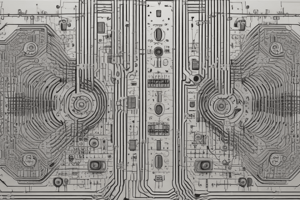Podcast
Questions and Answers
What characterizes linear circuits in relation to input and output?
What characterizes linear circuits in relation to input and output?
- The output is inversely proportional to the input.
- The relationship is quadratic.
- The output varies randomly regardless of input.
- The output is directly proportional to the input. (correct)
Which principle states that the total response in a linear circuit is the sum of individual responses to inputs?
Which principle states that the total response in a linear circuit is the sum of individual responses to inputs?
- Impedance
- Superposition (correct)
- Proportionality
- Time-Invariance
What does time-invariance mean in the context of linear circuits?
What does time-invariance mean in the context of linear circuits?
- Component values change with time.
- Circuit performance improves with time.
- Output does not depend on input over time.
- Circuit behavior remains consistent over time. (correct)
What is true about the stability of linear circuits?
What is true about the stability of linear circuits?
Which component is typically involved in linear circuits?
Which component is typically involved in linear circuits?
What effect does superposition have in analyzing linear circuits?
What effect does superposition have in analyzing linear circuits?
How can impedance in linear circuits be described?
How can impedance in linear circuits be described?
Which type of circuit is commonly associated with timing applications?
Which type of circuit is commonly associated with timing applications?
What is the cutoff frequency for an RC circuit defined as?
What is the cutoff frequency for an RC circuit defined as?
What is the time constant for an RL circuit?
What is the time constant for an RL circuit?
What behavior is exhibited by an RC circuit in relation to frequency?
What behavior is exhibited by an RC circuit in relation to frequency?
Which statement correctly describes the impedance of an RL circuit?
Which statement correctly describes the impedance of an RL circuit?
For an RC circuit, how long does it take for the voltage across the capacitor to rise to 63% of its final value?
For an RC circuit, how long does it take for the voltage across the capacitor to rise to 63% of its final value?
Which application is NOT typically associated with an operational amplifier (Op-Amp)?
Which application is NOT typically associated with an operational amplifier (Op-Amp)?
Which of the following statements is true about inductors in RL circuits?
Which of the following statements is true about inductors in RL circuits?
What does the impedance of an RC circuit depend on?
What does the impedance of an RC circuit depend on?
What is the ideal input impedance of an op-amp?
What is the ideal input impedance of an op-amp?
Which application is NOT typically associated with op-amps?
Which application is NOT typically associated with op-amps?
What does the slew rate of an op-amp indicate?
What does the slew rate of an op-amp indicate?
How is the output voltage of a voltage divider calculated?
How is the output voltage of a voltage divider calculated?
Which of the following best describes a common-emitter amplifier?
Which of the following best describes a common-emitter amplifier?
What does the term bandwidth refer to in the context of an op-amp?
What does the term bandwidth refer to in the context of an op-amp?
What is the output impedance of an ideal op-amp?
What is the output impedance of an ideal op-amp?
What characterizes the impedance of a voltage divider?
What characterizes the impedance of a voltage divider?
Flashcards
Linear Circuit
Linear Circuit
A circuit where output is directly proportional to input, and superposition applies.
Superposition
Superposition
The total response to multiple inputs is the sum of responses to individual inputs.
Linearity
Linearity
The output is directly proportional to the input.
Time-Invariant Circuit
Time-Invariant Circuit
Signup and view all the flashcards
RC Circuit
RC Circuit
Signup and view all the flashcards
Components of Linear Circuits
Components of Linear Circuits
Signup and view all the flashcards
Impedance
Impedance
Signup and view all the flashcards
Stability in Linear Circuits
Stability in Linear Circuits
Signup and view all the flashcards
Op-amp Ideal Characteristics
Op-amp Ideal Characteristics
Signup and view all the flashcards
Op-amp Open-Loop Gain
Op-amp Open-Loop Gain
Signup and view all the flashcards
Op-amp Bandwidth
Op-amp Bandwidth
Signup and view all the flashcards
Op-amp Slew Rate
Op-amp Slew Rate
Signup and view all the flashcards
Voltage Divider Purpose
Voltage Divider Purpose
Signup and view all the flashcards
Voltage Divider Rule
Voltage Divider Rule
Signup and view all the flashcards
Common-Emitter Amplifier
Common-Emitter Amplifier
Signup and view all the flashcards
Common-Emitter Amplifier Applications
Common-Emitter Amplifier Applications
Signup and view all the flashcards
RC Circuit Behavior
RC Circuit Behavior
Signup and view all the flashcards
RC Circuit Impedance
RC Circuit Impedance
Signup and view all the flashcards
RC Circuit Cutoff Frequency
RC Circuit Cutoff Frequency
Signup and view all the flashcards
RC Circuit Time Constant
RC Circuit Time Constant
Signup and view all the flashcards
RL Circuit: What is it Primarily Used For?
RL Circuit: What is it Primarily Used For?
Signup and view all the flashcards
RL Circuit Impedance
RL Circuit Impedance
Signup and view all the flashcards
RL Circuit Cutoff Frequency
RL Circuit Cutoff Frequency
Signup and view all the flashcards
RL Circuit Time Constant
RL Circuit Time Constant
Signup and view all the flashcards
Study Notes
Linear Circuits
- Linear circuits produce an output directly proportional to their input.
- Superposition principle applies; the total response is the sum of individual input responses.
- Common components include resistors, capacitors, inductors, operational amplifiers, and transistors.
Characteristics of Linear Circuits
- Proportionality (Linearity): Input and output have a linear relationship; doubling the input doubles the output.
- Time-Invariance: Circuit characteristics (like resistance) remain constant over time.
- Superposition: The overall response to multiple inputs is the sum of the responses to each individual input.
- Stability: Circuits designed to operate within stable limits, often via feedback mechanisms (as in operational amplifiers).
- Impedance: Well-defined impedance depends on resistance, reactance (from capacitors/inductors), and other components.
Resistor-Capacitor (RC) Circuits
- Used for filtering and timing applications.
- Exhibit frequency-dependent behavior due to resistor-capacitor interaction.
- Impedance is a function of frequency (ZRC = R + 1/(jωC)).
- Specifications:
- Cutoff frequency is where resistor and capacitor impedance are equal.
- Time constant (τ) is the time for voltage to reach 63% of its final value during charging or 37% during discharging (τ = RC).
Resistor-Inductor (RL) Circuits
- Primarily for filtering and applications where inductance is key (e.g., power supplies, radio frequency circuits).
- Inductors resist current changes, resistors limit current flow.
- Impedance is ZRL = R + jωL.
- Specifications:
- Cutoff frequency (fc) defined similarly to RC circuits.
- Time constant (τ) defined similarly to RC circuits (τ = L/R).
Operational Amplifier (Op-Amp) Circuits
- High-gain voltage amplifiers with differential input and single-ended output.
- Used in various configurations (inverting, non-inverting, integrators, differentiators, followers).
- Ideal op-amps have infinite input impedance, zero output impedance, and infinite open-loop gain.
- Specifications:
- Open-loop gain (typically very high).
- Bandwidth (frequency range where gain is maintained).
- Slew rate (maximum rate of output voltage change).
- Input impedance (ideally infinite).
- Output impedance (ideally zero).
Voltage Divider Circuits
- Simple linear circuit dividing the input voltage proportionally using two resistors.
- Output voltage is determined by resistor values (Vout = Vin * (R2 / (R1 + R2))).
- Parallel resistance formula for impedance (Zdiv = R1 || R2).
Common-Emitter Amplifier (Transistor Amplifier)
- Input signal to base, output from collector, emitter grounded.
- Provides voltage amplification.
- Suitable for audio and radio frequency applications.
- Specifications:
- Voltage Gain, Input and Output Impedance, Bandwidth.
Studying That Suits You
Use AI to generate personalized quizzes and flashcards to suit your learning preferences.





